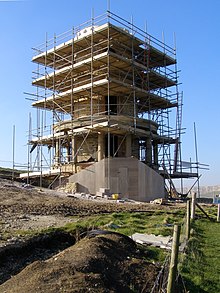Clavell Tower
Coordinates: 50 ° 36 '26.9 " N , 2 ° 7' 47.4" W.
The Clavell Tower is likely a folly . It is also known as the Clavell Folly or the Kimmeridge Tower . The structure is also known as the Tower of the Winds .
location
The Clavell Tower was built on a rock face near Kimmeridge , on the Jurassic Coast of the English Channel , on the Isle of Purbeck in the county of Dorset on the south coast of England . Kimmeridge is about 6 km south of Wareham , about 4 km southwest of Corfe Castle and 8 km west of Swanage . The Clavell Tower stands on a rock wall known as Hen Cliff .
history
Clavell Tower was built by Reverend John Richards Clavell of Smedmore House in 1830. He changed his name from Reverend John Richards to John Richards Clavell when he inherited the Smedmore property in 1817.
The tower is about eleven meters high and stands on a rock wall (Hen Cliff), which rises about 100 meters above sea level. The main tower was built from selected natural stone, the window frames from bricks. The ground floor is surrounded by a Tuscan colonnade and the roof and its parapet are made of Purbeck stone . The tower has a total of four floors; A stone ground floor, above a stone one, carries the three upper floors made of wood.
There is evidence that there were fireplaces on the first floor. This would suggest that year-round use was the intention. Access to the upper floors was only possible via a ladder.
The writer Thomas Hardy often took his first love, Eliza Nicholl, to the Clavell Tower. He used an illustration of the building in his work Wessex Poems . The local coast guard used the tower as a lookout point until the 1930s when it burned out. The desolate condition of the Clavell Tower was the inspiration for Baroness PD James ' novel The Black Tower . The story is about a woman in a wheelchair who was pushed over the edge of the cliff.
Transfer
The Clavell Tower is owned by the Landmark Trust. The tower over Kimmeridge Bay was threatened by coastal erosion and was in danger of falling into the sea. It was relocated 25 meters inland between September 5, 2006 and February 25, 2008, away from the crumbling rock faces.
Its 16,272 stones were removed, numbered, photographed and reassembled by engineers and specialized construction workers. The interior has also been renovated. The cost of the renovation was estimated at around £ 900,000.
Tower of the Winds
The question remains: what is the Clavell Tower? A garden house, an observatory, a lookout point or a watchtower? Or just a folly? The latter has the greatest credibility as it is built relatively simply and it would certainly have been problematic to live in. On the other hand, it is very charming to look at.
The tower is high and exposed on a cliff, this is a reason for another name, Tower of the Winds . On the other side of the bay, also lonely and isolated, there is a so-called horse head pump . Oil has been pumped out of the cliffs since the late 1950s. The largest European onshore oil field is on Wytch Farm, not far away.



